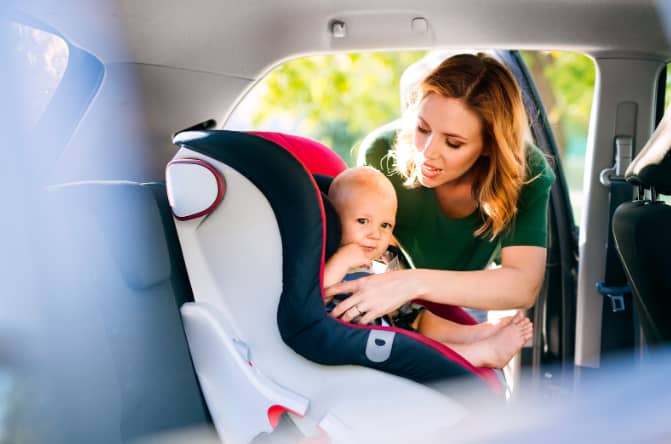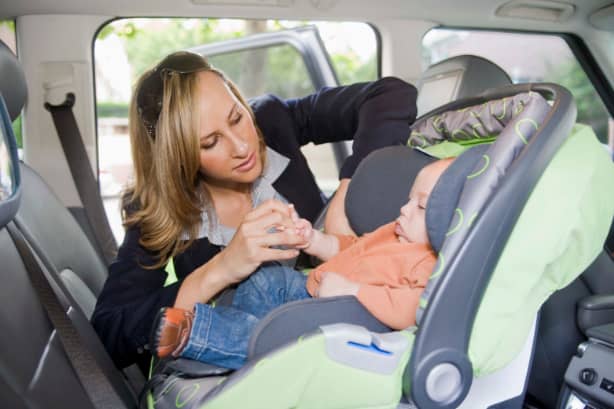Assume you are planning a trip, but suddenly you get upset by thinking about you and your child’s car sickness. Isn’t it a sad thing? Dealing with car sickness is unpleasant and destroys your trip’s entire feeling.
But don’t worry. There are several ways to deal with car sickness and make your and your child’s ride comfortable. Car sickness’s common symptoms are headache, vomiting, dizziness, nausea, restlessness and others. If any of these symptoms are in your child, be sure they suffer from motion sickness.
The utmost tip for parents to combat their baby’s car sickness is to contact the healthcare provider and take natural remedies or medication. Also, you can prevent car sickness by following several rules like keeping your baby well-hydrated, ensuring they aren’t watching mobile or playing games during rides etc.
We will explore more information on car sickness, its symptoms, remedies, prevention etc. So, keep going till the end without escaping any points.

What Is Car Sickness?
Before directly jumping to the discussion of how to deal with car sickness, first, you must know what car sickness is. However, according to Toni Brayer, when the brain receives conflicting information from the inner eyes, ears, and the joints and muscles nerves, it causes motion sickness.
Normally our brains integrate and compare the messages it receives from the inner parts. Confusing messages in the brain cause sweating, nausea and an unwell feeling.
Anyone can experience car sickness while traveling. But the children aged from 2-12 and women tend to feel motion sickness most.
Your child can experience motion sickness due to the following factors also:
- Inner ear disorders and
- Family history, like parent’s motion sickness problem
Car sickness is the children’s most common motion sickness form. While traveling from one place to another by train, bus, plane or boat anytime it can happen. Also, your child can experience car sickness while riding in the amusement park or playing on playground equipment.
What Are The Car Sickness Symptoms In Children?
The car sickness’s dramatic indication is that your child is vomiting. But not necessarily every child will vomit who experience motion sickness. The symptoms that your children are dealing with car sickness are:
- Headache
- Fatigue
- Nausea (With or without vomiting)
- Cold sweats
- Dizziness
- Increased saliva
- Irritability
- Pallor (Pale skin)
- Difficulty concentrating
- Gulping for air or rapid breathing
- Loss of appetite
- Yawning
- Restlessness
- Crying
Some babies usually let their parents know that they are feeling queasy. Also, sometimes your child can recognize the car sickness symptoms independently if they have experienced it before.
The younger babies, like 06-15 months old, can’t explain their feelings. So as a parent, keep an eye on your babies during traveling. If your child expresses any of the above symptoms, they feel car sickness.
Tips For Parents To Ensure A Comfortable Ride For Their Child
If your child has car sickness, don’t worry, it’s not a major issue. Rather motion sickness is common in both children and adults. Usually, you don’t need to visit the healthcare provider if your baby has normal motion sickness.
But if any of the above symptoms are visible or your child has severe sickness, then they require enough medication. When car sickness becomes too severe, we recommend you visit your child’s pediatrician to manage it easily.
General Tips
Go to the healthcare provider to diagnose motion sickness. They will ask about the symptoms that your child is experiencing. And sometimes, they may do your child’s physical exam, particularly of their ears and eyes. You should take your children to the healthcare provider if:
- Your baby has car sickness symptoms when they aren’t traveling or involved in movement activity.
- They have difficulty seeing, hearing, talking or walking
- Your child stares off into space, and they have a headache
Your child isn’t in motion, but motion sickness a severe condition is visible in them. And it warrants a visit of your baby to the healthcare provider. You should consult a doctor or pediatrician because your child can be prone to migraines if they feel extreme motion sickness.
Car Sickness Treatment
So our next tip for you is to provide treatment for your kid’s car sickness. Your child can grow out of car sickness as their body learns to adapt to the mixed signals. When your child’s body gets used to the motion, the sickness often resolves.
However, car sickness treatments are natural remedies and medication. Now one by one, we will explain the effects of this treatment in detail. So keep going!
Natural Remedies
Car sickness’s best treatment is to stop traveling in a car or stop movement-related activities. Stop all the activities, and let your baby stay still. But the problem is this is not a permanent solution as it’s not always possible.
The other options instead of stopping riding in the car are:
- When your child feels nausea, offer ginger tea, ginger ale or peppermint tea.
- Put your child’s hand out of the car’s window. It will allow the cold air to hit the hand to blunt the signals properly to the brain. But you must do it safely.
- Sucking on ginger candy or sour candy. Before giving candy to your child, ensure they are old enough that the candy won’t create a choking hazard.
- Look at the horizon out of the window.
- Put acupressure wristbands on your child’s hand.
Distractions like pointing things out of the window or listening to music are helpful. However, avoid distractions like books, toys, dealing with other objects or playing games in the car. All these increase your child’s car sickness possibility.
Medications
Are you disappointed because the above natural remedies won’t work to treat your child’s motion sickness? If so, don’t worry. Natural remedies are one of the options, but it’s not the only option. When none of the above works, then another option is medication.
Medication is especially helpful for children who frequently get car sickness on long journeys. Anyway, the medicine for your kid’s motion sickness includes:
- Bonine (Meclizine): Only children of 12 years or older are allowed to take this as it is an over-the-counter medicine. Before 12 hours of your trip, give Meclizine to your child as it is slow acting.
- Antihistamines (For example, Dramamine): Dimenhydrinate or Dramamine can alleviate your child’s car sickness symptoms. If your baby is younger than age 2, avoid giving it to your child. And for your child of age more than two and older, give them medicine’s dose carefully.
- Scopase: Scopolamine or scopase is usually administered via the skin’s patch. However, it is allowed to be used on the prescription only. It is approved for people more than 12 years of age.
Using these medications can come with different side effects, like drowsiness. So if you want to give medicine to your child, plan ahead. These medicines can interact with other medications. So carefully give medicine to your child.
Before giving any medicine to your baby, always consult with the pediatrician or your child’s healthcare provider.
How To Prevent Your Kid’s Car Sickness
There is a common proverb that prevention is better than cure. Regarding car sickness, this proverb is true, and prevention can go a long way.
However, the first rule to prevent car sickness is never to look down at a phone or tab or never read a book when riding in a car. Parents can follow the tips below to keep their children safe during the car trip.
- Before starting your trip, plan its route perfectly, including its most frequent stops.
- During the trip, try to take a nap.
- Keep your child well-hydrated
- Before and during your travel time, avoid taking big meals. Take a bland snack and avoid being hungry for over 3 hours.
The seating choice is another important consideration. It can also make a difference in whether you will feel car sickness. When traveling, always face forward.
Anyway, to prevent car sickness, seat in the following ways:
- Car: The best option is the front passenger seat
- Boat: On the boat’s middle. If there are multiple levels, then sit on the upper desk
- Cruise Ship: On a lower level cabin toward the ship’s front or middle
- Plane: Wing section
- Bus: By the window
- Train: It’s a forward-facing window seat.
Now let’s look at the following preventions steps in detail:
1. Keep Cool
If your child starts complaining that they suffer from warmth, take it as a big sign of car sickness. From being warm within a short time, your child will be sick. So ensure your car’s inner side is cool enough.
Keep the Air conditioner on if traveling in an AC bus or train. And in the case of non/AC vehicles, open their windows so air can enter them.
2. Admire The Outside View
If you focus on a screen or book while riding, it will make your car sickness worse. So coloring, DVDs, books, tablets, or video games cannot be enjoyed during your ride time.
Encourage your baby to look outside to admire the view. Looking outside will reduce car sickness to a great extent.
3. Take A Nap
It will be better if your child can nap during travel time. When your baby closes their eyes, it will relieve their car sickness. So ask your baby to keep their eyes closed. Taking a nap while driving will save your baby from boredom and nausea.
4. Have Ready Your Car Sickness Kit
Always have the car sickness kit ready for you, your baby and your family, especially when you are going on a long trip.
5. Be Wary Of Colds
Your child’s car sickness increases or worsens when they feel congested. If your children have an allergy or a cold, they will get car sick again due to the stuffed-up in the car.
So be careful and avoid winding roads and traffic jams. Try to ensure the safest journey for your baby.
6. Skirt Traffic
The lurching motion, like stop-and-go, is the worst for people with car sickness problems. Even from time to time, it makes people queasy. But the problem is traffic is unavoidable and too common.
So when you get stuck in traffic, be easy, take control of yourself and try to avoid the lurching motion.
Frequently Asked Questions
How Can I Reduce The Symptoms of Motion Sickness In My Car?
To reduce car sickness symptoms, sit on the bus or car’s front, and on flights and trains, choose a window seat. If possible, lay down, look at the outdoor horizon or shut your eyes and sleep.
How Do You Survive A Long Car Ride With Motion Sickness?
Avoid eating greasy, spicy and fatty foods, drink ginger ale, breathe in the fresh air, sit in the front seat, try wristbands etc.
How Do You Prevent Car Sickness Naturally?
To naturally prevent your car sickness, take control, keep your eyes on the outdoor horizon, change positions, and nibble on crackers. Or distract yourself with conversation or music.
Final Thoughts
Dealing with car sickness during your ride time will wipe away your journey’s all happiness. On top of that it will give you a stressful trip. So if you or your child is car sickness prone, you must take action to prevent your riding from being disturbed.
Even after following all the tips mentioned above and prevention steps, if your child becomes sick, immediately at a place, stop your car. Get out, rest and walk around with your child. If your child is still feeling bad, allow them to relax with their eyes shut.
Hopefully, following all the above tips, you will have a carsick-free fun trip.






